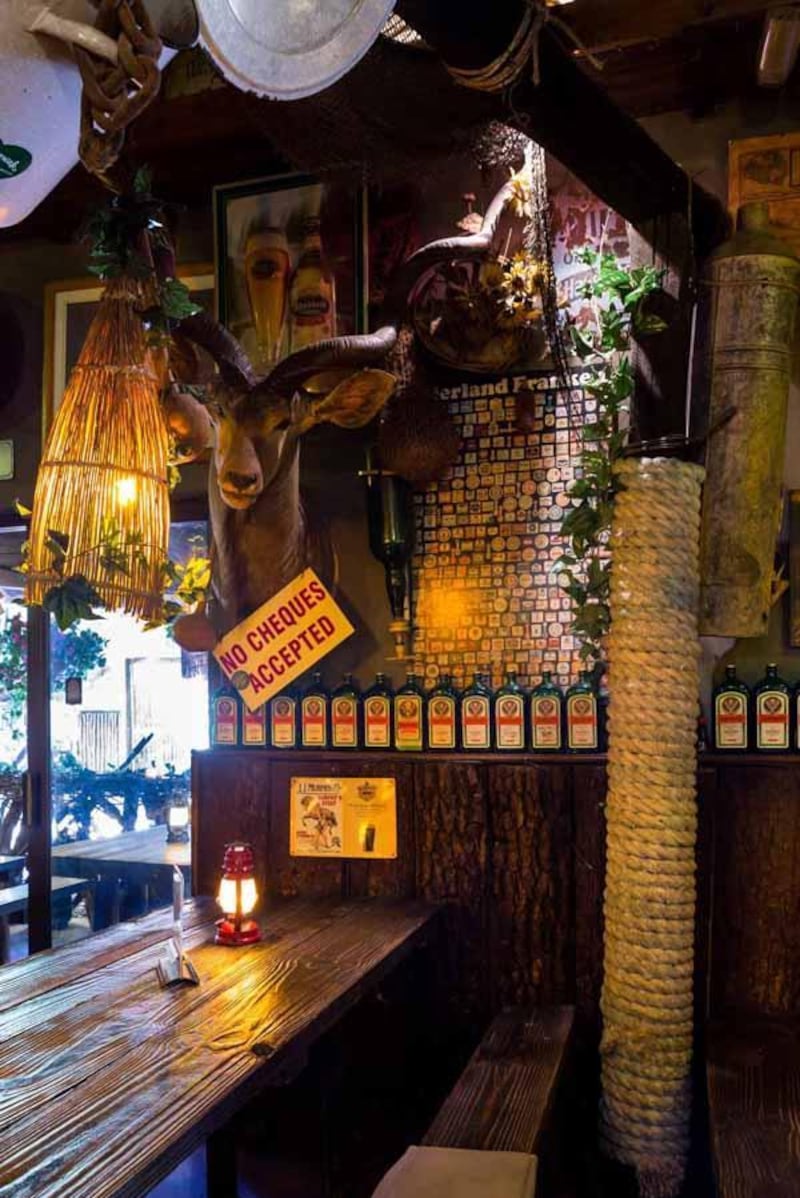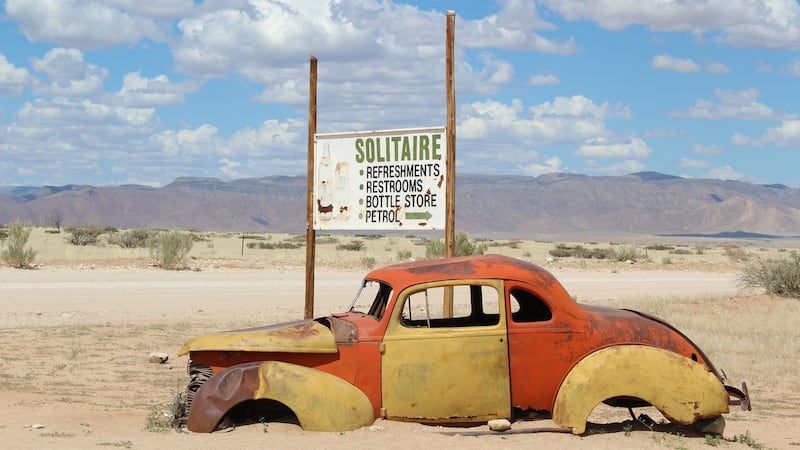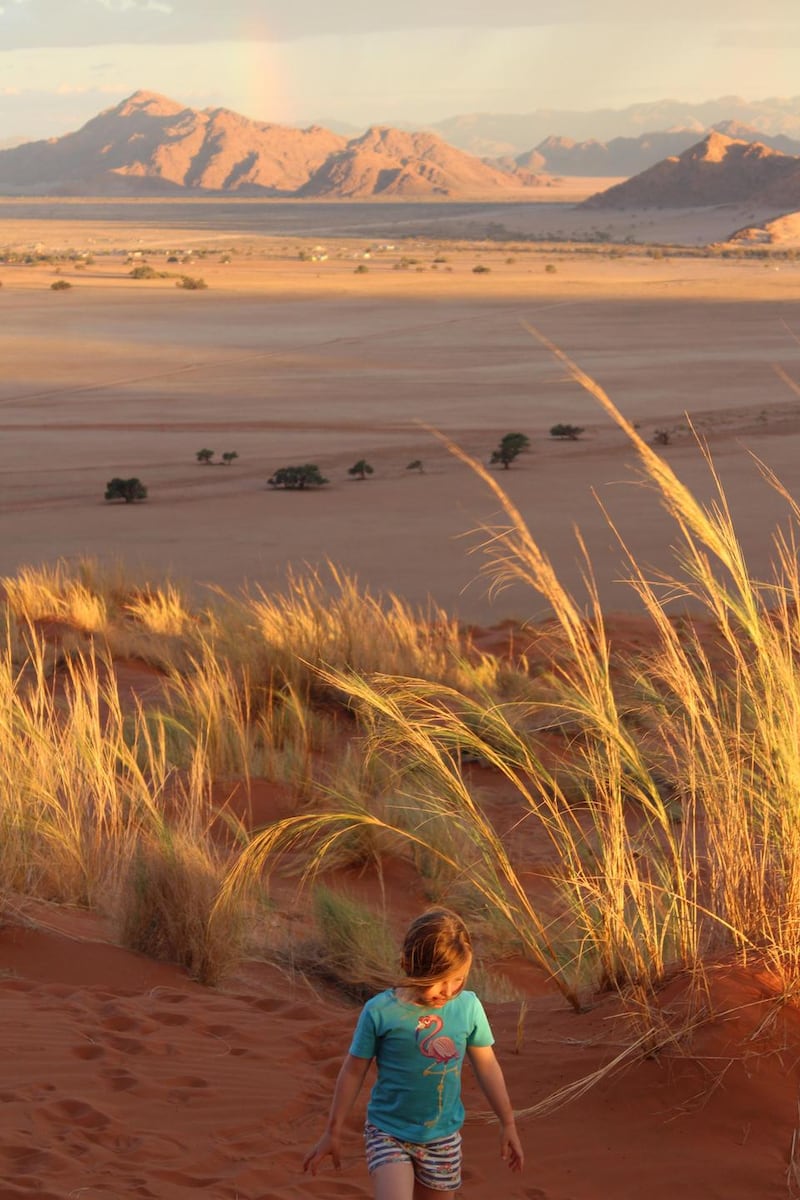Windhoek, the capital of Namibia, where most travels around the country begin and end, has a slightly frontier feel. Wide boulevards, modern buildings and occasionally a German-style colonial building and street names like Bismarck Strauss hark back to the days when this part of Africa was Deutsch-Südwestafrika. Imaginatively designed municipal buildings attest to the newness of the country. Namibia only achieved independence from South Africa in 1990, and while some streets bear the names of independence heroes and first president Sam Nujoma, one is named after Seán McBride who as a UN commissioner was tireless in seeking independence for Namibia.
The city is responding to a rise in visitor numbers, with new hotels and fashionable restaurants, but a standard on any visit is Joe’s Beerhouse, an African-Bavarian experience in a series of thatched cottages full of hanging curiosities, stuffed animals and shelves of empty Jägermeister bottles. Joe’s is a Namibian Johnnie Fox’s, only this menu has game steaks such as zebra, oryx and crocodile.

0 of 3
Driving a 4X4 is a standard way of getting around in a country larger than France, where a large part is desert or under national park protection and most of the roads are unpaved or gravel. It's also one of the least-populated countries in the world. At Savanna Car Hire, each jeep comes equipped with everything from a fridge to a gas cooker and pots and pans. Our pre-booked four-wheel drives had foldout collapsible roof tents and a Jacob's ladder connecting you to the ground. Sleeping this way was the highpoint of the holiday, according to our six-year-old daughter. Roof tents have the advantage of protecting you from wild animals while allowing a comfortable base to sleep upon. Namibia is full of campsites, so it's the way to go. After lunch at the Alliance Française café we were ready for off.
Bush veld
We were soon into spectacular open countryside heading south, rolling plains, bush veld and the open road stretched out under a vast sky. There had been rain recently – the first in years – and everywhere was tinged with green. Sometimes the only indication of an occasional farm was a steel windmill towering over bush and scrub.
Our first campsite, Namibgrens Mountain Camp, was situated in a rock amphitheatre, with a swimming pool in its centre scooped out of rocks. We unfolded our roof tents and started cooking, surrounded by boulders glowing furious red in the evening sun. At night, you could look up at the stars in probably one of the least light-polluted parts of the planet.
Setting out for Sossusvlei, we soon realised we were on a spectacular height and, at Spreetshoogte Pass, a parched plain spread out below us to distant red and ochre mountains that the guidebook told us were petrified dunes. This was the Namib Desert, the oldest desert in the world, running from Angola through Namibia to South Africa.
We stopped at Solitaire, a kind of wild west halfway house, with general store, garage and German bakery selling apple strudel. Outside, ancient cars rusted under the 40-degree midday sun.

Passing through the Sesriem gate, we reached the dunes of Sossusvlei in the Namib-Naukluft National Park. The dunes present a serious challenge to climb because of sinking feet and the sense you are getting nowhere; the ridges can be hundreds of feet high but it's always safe to fall. We reached the top, had some sundowners and looked over one of the strangest landscapes I've ever seen, a red sea of mountainous dunes and plains – like surveying the surface of Mars.
Dry riverbed
Further on was Deadvlei or “dead marsh”, where the remains of 800-year-old black trees stood out in a dry riverbed. This ghostly otherworld landscape is, for Namibians, one of the eight wonders of the world.
Next was an all-day drive northwest to Swakopmund through a desert landscape of gorges, dried riverbeds, black rock and areas with a sheen of green resembling distant pasture. By afternoon we were seeing mirages of blue water, which disappeared when I put the camera to them. The only sign of civilisation was the occasional burst tyre; we stopped and I walked in a straight line for a few hundred yards across a floor of quartz.
Eight hours’ driving later we turned west towards the coast, bypassing Walvis Bay for the quaint and misty Swakopmund where we would spend two nights in an Airbnb villa overlooking the sea. The washing machine never stopped. The dust from the desert, including a sandstorm, had infiltrated everything inside our jeep; all was coated with chalky dust like a Pharaoh’s tomb.
Swakopmund is a lost and mysterious seaside place, backed by the desert and fronted by the Atlantic, which is made even colder by the Benguela current from Antarctica. There's virtually no rainfall here, only mist, which burns off early. Some years ago Angelina Jolie and Brad Pitt came here to have their first child and to avoid world media attention.

Military ambulance
Next day was a pre-booked tour with Turnstone Tours where we were collected in a Land Rover-bus that had seen action as a military ambulance in Iran. Soon we were off down the coast towards Sandwich Bay. This coast makes for treacherous driving as the dunes bank right up to the sea and there's shifting sands and spring tides. The wildlife was stunning, from flocks of flamingos, pelicans, jackal buzzards and even a beetle that has evolved to collect mist on its back for a morning drink. As we ate lunch on the beach at the Kuiseb estuary, an eerie rumbling sound could be heard – the sound of wind disturbing billions of sand particles.
After another marathon drive, we reached Etosha early in the morning (the park opens at sunrise and strictly closes at sundown). The name Etosha can mean “place of emptiness” and it is one of Africa’s great national parks, ranking with South Africa’s Kruger. And hundreds of mammals, reptiles and bird species have been recorded here.
Etosha also means "great white place", a reference to the saltpan it's centred around. It's a huge depression – about the size of Co Kerry, while the surrounding park is about the size of Munster. The saltpan becomes a shallow lake in summer and sometimes elephants or buffalo-like wildebeest are sighted, dusted ghostly in white.

Floodlit watering-hole
There are three campsites in the park; we stayed at Halali, with an Olympic-sized swimming pool, restaurants and facilities, including its own floodlit watering-hole.
We saw a staggering amount of wildlife, from a single black rhino to giraffe, oryx, hartebeest, jackals, meerkats and even mongoose, dazzles of zebra and implausibilities of wildebeest. On the bird front, everything from the Kori bustard (the largest flying bird in Africa), to hornbills, beautiful bee-eaters and the totemic lilac-breasted roller.
Some animals proved elusive, but, on our last morning, my wife sighted a lioness and, close by, a wild male. It was the icing on the cake or the salt on the pan. The driving was shy of 2,500 km in nine days but with so many vistas, sightings and material for the memory bank, it is one of the best – if least relaxing – trips we have ever taken.













